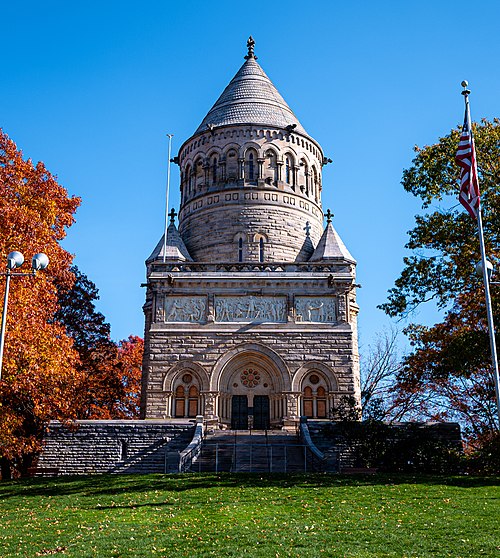Erik Visits an American Grave, Part 33
This is the tomb of James Garfield:
Garfield grew up in Ohio, raised by his widowed mother. He attended Williams College in Massachusetts, moved back to Ohio and entered politics as a Republican. He served in the Ohio state senate from 1859-61 and then volunteered for the Union Army during the Civil War. He rapidly rose to the rank of major general, fighting at Shiloh, among other battles. However, his war service ended in late 1863 when he was elected to Congress in 1862; nearly a year between the election and the start of the next legislative session was the norm at that time. In that year, he also fought effectively at the Battle of Chickamauga. After he left for Washington, he became a protege of Salmon Chase and aligned himself with abolitionists who felt that Lincoln was moving too slow on slavery, particularly in following Thaddeus Stevens’ advice to confiscate the lands of treasonous plantation owners and redistribute them to their former slaves. In the early years of Reconstruction, Garfield continued his alliance with the radical Republicans, hoping to impeach Andrew Johnson and being shocked and angry when that failed.
But by 1870, Garfield was rapidly moving toward a more conservative position. While he supported the 15th Amendment, he did not support the Ku Klux Klan Act of 1871, critical to Grant’s suppression of the KKK, because he worried about the effect upon habeas corpus. He became a classically Gilded Age hard money supporter, deriding greenbacks.
Like other politicians of the period, Garfield also had shady financial morals. He was caught up in the Crédit Mobilier scandal. Although it did not seem that he directly accepted Union Pacific money, he certainly was aware of the scandal and was personally offered money. At the very least, he knew about the entire scandal as a powerful congressmen and did nothing at all about it. This did not hurt him in the future. He got himself elected to the Senate with the support of the state’s powerful senator John Sherman and quickly became a dark horse for the Republican nomination in 1880. Ulysses S. Grant, who was actively seeking a third term after taking four years off, James Blaine, and John Sherman were the early favorites. When none of the three could win a majority of delegates, support began to move toward Garfield. He won election that fall over Winfield Scott Hancock. Horatio Alger wrote his campaign biography; you already know what Alger emphasized in it.
The major issue Garfield faced as president was the division between the two factions of the party, a division made clear to him as Grant’s supporters refused to support him until the very end. This of course would help lead to his assassination by the disgruntled office seeker Charles Guiteau in 1881. Some have claimed Garfield would have made a good civil rights president, but I am skeptical. He would have been good for African-Americans on patronage and he did propose some educational programs, but the general feeling within the Republican Party for aggressive action to protect black rights in the South was very low in 1881. Even if he had survived the full four years, it’s unlikely any bill would have passed for him to sign and probably not likely that he would have spent much political capital on it, although I guess we will never know.
Garfield’s tomb is big enough but it’s the inside that is really amazing. 1881 was Peak Gilded Age. Money was flowing and Garfield was part of that monied elite by this time. His policies had helped make a lot of wealthy people wealthier. So they went all out for Garfield. I visited the grave before and have been inside, but when I visited this March, the inside was closed. But these pictures other took will do.
Here is the statue of Garfield inside the tomb, with the sun reflecting on the glorious man, reminding us all of his awesomeness. In the background, you can see the ornnateness of the entire thing, which includes up to the high rotunda. That’s even better seen here:
Here is the actual grave:
James Garfield is buried in Lake View Cemetery, Cleveland, Ohio.






